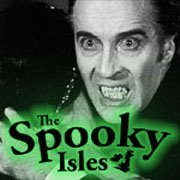Miss Leslie’s Dolls (1973) | This demented schlock horror is a camp delight!
Whatever you do, don’t go by the IMDb listing for this 1970s schlockfest, which is supposed to be about ‘a gay drag queen with a mother fixation who terrorizes a city, hunting down, killing and dismembering women’. While that sounds like something I’d rather like to see, Miss Leslie’s Dolls is actually about a maniac obsessed with transporting her spirit into the bodies of young women, while the ‘dolls’ of the title are the preserved corpses of the girls she failed to possess.
With long black Morticia Addams hair, bushy eyebrows and five o’clock shadow, and dressed in a matronly purple robe, Miss Leslie looks like Aleister Crowley in Norma Bates drag. Now it’s pretty obvious from the outset that she’s being played by a bloke (Miami theatre actor Salvador Ugarte) being dubbed by a woman, but it all makes sense in the end and the road to the reveal is an absolute hoot.
This trangressive spin on the Old Dark House and House of Wax sees students Martha (Kitty Lewis), Lily (Marcelle Bichette), Roy (Charles Pitt) and their teacher Alma (Terri Juston) seeking shelter from a storm at Miss Leslie’s remote home in the woods.
On setting eyes on the lonely middle-age woman’s tableaux of female statues, the teens suspect her of belonging to some weird love cult, but Miss Leslie explains that she has long held a fascination for dolls and for creating life size ones as her family once owned a doll factory that was burned down in a fire. Martha, meanwhile, is the spitting image of the girl Miss Leslie was in love with 20 years ago.
Things go all Thundercrack meets Psycho as soon as the lights go out, with the students and their teacher getting in some bed swapping and heavy petty (Roy’s a bit of a sex god, and there’s some girl-on-girl action), while ‘girl worshipper’ Miss Leslie heads to the cellar for an emotional heart-to-heart with the skull of her dead mother, whom she blames for her murderous acts. We then learn that all Miss Leslie wants in life is to be desired – and to do that, she needs to be reincarnated into the body of a young woman. Oh dear… there are three potential candidates upstairs!
What happens next is really ‘Out there!’ – with the standout scenes involving the waxwork ‘dolls’ coming to lurid life; Martha, Lily and Roy being chased by Miss Leslie armed with an axe dripping in blood, and a drugged Alma, dressed in baby doll negligee and fluffy mules, trying to escape from the deranged maniac. So does Miss Leslie succeed in her spirit swapping? Well you’ll have to see the film to find out. But I can reveal that’s there’s a neat twist at the end.
For decades this would-be cult classic was considered lost, and doesn’t even get a mention in any of my cult film reference books, including Michael Weldon’s Psychotronic Encyclopaedia (my go-to book for the weird, the strange and the freakish). But kudos to Network Distributing and The Erotic Film Society’s Julian Marsh for unearthing this hidden gem (which I’ve now watched three times).
As I’ve mentioned, the film shares its DNA with a host of other genre classics, with Psycho being the obvious one. Shot at the same studios in Florida where Hershell Gordon Lewis lensed his grand guignol offerings, it has the look and feel of the godfather of gore’s grindhouse flicks (especially Gruesome Twosome), but also has shades of Ed Wood’s Glen Or Glenda and even Beyond the Valley of the Dolls running through its exploitation veins.
There’s much debate as to who really directed this bizarre cinematic experience, which is all explained in the booklet, written by film historian Laura Mayne, which accompanies Network’s release, but that doesn’t matter, as this is a hugely enjoyable slice of cheap and sleazy 1970s horror, which also benefits from an unusual score by the film’s screenwriter (Ralph Remy Jr as Imer Leaf) that fuses the space-age electronic sounds of Bebe and Louis Barron’s music to Forbidden Planet (1955) with Bobby Beausoleil’s otherworldly orchestral score to Kenneth Anger’s Lucifer Rising (1972).
Newly scanned from one of the few surviving prints in its original theatrical aspect ratio of 1.85:1, Miss Leslie’s Dolls is out on Blu-ray, DVD and Digital on 3 September from Network.
Posted on September 1, 2018, in Exploitation, Horror, LGBTQ+, Must See, Sleaze and tagged LGBTQ+, Miss Leslie’s Dolls, Network Distributing. Bookmark the permalink. 3 Comments.






















Pingback: Miss Leslie’s Dolls (1973) | This demented schlock horror is a camp delight! — Kultguy’s Keep – neweraofhorror
Pingback: Miss Leslie’s Dolls (1973) | This demented schlock horror is a camp delight! — Kultguy’s Keep – House at Highgate Cemetery
Pingback: Miss Leslie’s Dolls – USA, 1973 – HORRORPEDIA: uncut